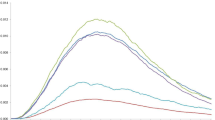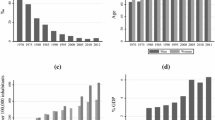Summary
The relationship between poverty and several health-related characteristics in West Germany was investigated. Data were derived from the National and Regional Health Surveys conducted in West Germany from 1984 to 1992. 25544 males and 25719 females with German nationality aged 25–69 years were examined. Poverty was defined as a household income of 50% less than the mean for West Germany. Multiple logistic regression analysis was used to analyze the relationship between poverty and four health variables: individual health behavior, subjective assessment of health status, cardiovascular disease risk factors, and self-reported prevalence of lifetime chronic diseases. 10.2% of males and 12.8% of females were classified as being below the poverty line. For most but not all health parameters, less favourable results were found for the segment of the population with a household income below the poverty line. The most striking poverty-related differences were observed for lack of regular sport activities, subjective health satisfaction, obesity and myocardial infarction/stroke. Significantly lower prevalence rates for study subjects below the poverty line were observed for hypercholesterolemia in females only. Allergic disorders were the only chronic diseases reported significantly less often in males and females below the poverty line. Poverty has strong effects on individual health status and the prevalence of chronic diseases. Due to the rising unemployment rates in Germany in the last years it is very likely that the strong negative consequences of poverty for health are increasing.
Zusammenfassung
Es wird untersucht, welche Zusammenhänge zwischen Armut und verschiedenen gesundheitsbezogenen Merkmalen bestehen. Datenbasis sind die nationalen und regionalen Gesundheitssurveys, die in den Jahren 1984 bis 1992 in Westdeutschland durchgeführt wurden. 25544 Männer und 25719 Frauen mit deutscher Nationalität im Alter von 25 bis 69 Jahren wurden einbezogen. Armut wurde definiert als ein Haushaltseinkommen, das um 50% niedriger ist als das mittlere Einkommen in Westdeutschland. Die statistische Auswertung erfolgte mittels multipler logischer Regressionsanalyse, 10,2% der Männer und 12,8% der Frauen hatten ein Haushaltseinkommen unterhalb der Armutsgrenze. Die ausgeprägtesten armutsbezogenen Unterschiede wurden beobachtet für den Mangel an körperlicher Bewegung, die subjektive Gesundheitszufriedenheit, das starke. Übergewicht und die kardiovaskulären Krankheiten. Signifikant niedrigere Prävalenzen für Personen mit Einkommen unterhalb der Armutsgrenze ergaben sich bei den Frauen für den Risikofaktor Hypercholesterinämie. Allergien waren die einzige chronische Krankheit, die bei beiden Geschlechtern signifikant seltener in der von Armut betroffenen Bevölkerungsgruppe berichtet wurde. Vor dem Hintergrund der in den letzten Jahren stark angestiegenen Arbeitslosigkeit in Deutschland ist zu befürchten, dass die negativen Konsequenzen der Armut für die gesundheitliche Lage deutlich zugenommen haben.
Résumé
Les rapports entre pauvreté et differents indices sanitaires ont été examinés. Les donnees proviennent des surveys de santé nationales et régionales, réalisées en Allemagne de l'Ouest durant les années 1984 à 1992. 25719 femmes et 25544 hommes de nationalité allemande entre 25 et 69 ans ont paticipé. Le seuil de pauvreté a été fixé à un revenu égal a 50% du revenu moyen en Allemagne de l'Ouest. On a analysé les indices sanitaires suivants: le comportement sanitaire individuell, l'auto-estimation de sa santé, les facteurs de risque cardio-vasculaires et la prévalence des maladies chroniques. L'analyse statistique a été réalisée par regression logique multiple. 12,8% des femmes et 10,2% des hommes avaient un revenu inferieur au seuil de pauvreté. Pour la majorité des indices sanitaires on a trouvé des résultats défavorables pour la groupe ayant un revenu au dessous du seuil de pauvreté. Le manque de mouvement, l'auto-estimation de sa santé, l'excés de poids et les maladies cardio-vasculaires sont les indices quid diffèrent, relatif à la pauvreté, le plus. Les femmes ayant un revenu au-dessous du seuil de pauvreté ont des pourcentages de prévalence inférieurs significatifs pour le facteur de risque hypercholestérolémie. Les allergies sont les seules maladies qui existent significativement moins souvent chez les deux sexes de la groupe des pauvres. En résumé, la pauvreté présente un désavantage pour la santé individuelle et la prévalence des maladies chroniques. Sachant que le taux de chômage s'est aggravé pendant les dernières années, il est à craindre que les effets négatifs de la pauvreté sur la situation sanitaire ont nettement augmenté.
Similar content being viewed by others
References
Hauser R, Neumann U. Armut in der Bundesrepublik Deutschland. Die sozialwissenschaftliche Thematisierung nach dem zweiten Weltkrieg. In: Leibfried S, Voges W. Hrsg. Armut im modernen Wohlfahrtsstaat. Kölner Zeitschrift für Soziologie und Sozialpsychologie, Sonderheft 32. Opladen: Westdeutscher Verlag, 1992: 237–271.
Hanesch W, Adamy W, Martens R, Rentsch D, Schneider U, Schubert U, Wisskirchen M. Armut in Deutschland. Hamburg: Rowohlt, 1994.
Zwick MM Hrsg. Einmal arm, immer arm? Neue Befunde zur Armut in Deutschland. Frankfurt/New York: Campus Verlag, 1994.
Statistisches Bundesamt Hrsg. Sozialhilfe (Sozialleistungen, Fachserie 13, Reihe 2). Stuttgart: Metzler-Poeschel, 1994.
Offermann V. Die Einkommens- und Vermögensverteilung in Deutschland 1992. Sozialer Fortschritt 1993;42:121–124.
Luft HS. Poverty and Health. Economic causes and consequences of health problems. Cambridge, Massachusetts: Ballinger Publishing Company, 1978.
Davis K, Schoen C. Health and the war on poverty: A ten-year appraisal. Washington, DC: The Bookings Institution, 1978.
Davey Smith G, Bartley M, Blane D. The Black report on socioeconomic inequalities in health 10 years on. Brit Med J 1990;301:373–377.
Hahn RA, Eaker E, Barker ND, Teutsch SM, Sosniak W, Krieger N. Poverty and death in the United States 1973 and 1991. Epidemiology 1995;6:490–497.
Deutscher Gewerkschaftsbund Bayern Hrsg. Leben ohne Würde. Armut in Bayern. Bayerischer Armutsbericht 1994. München 1994.
Huster EU. Gesundheit-Risiken und Unterversorgung. In: Döring D, Hanesch W, Huster EU Hrsg. Armut im Wohlstand: Frankfurt am Main: Suhrkamp Verlag, 244–269.
Leibfried S, Voges W Hrsg. Armut im modernen Wohlfahrtsstaat. Kölner Zeitschrift für Soziologie und Sozialpsychologie, Sonderheft 32. Opladen: Westdeutscher Verlag, 1992: 237–271.
Mielck A Hrsg. Krankheit und soziale Ungleichheit. Sozialepidemiologische Forschungen in Deutschland. Opladen: Leske und Budrich, 1994.
Siegist J. Soziale Ungleicheit und Krankheit (Editorial) Soz Präventivmed 1993;38:3–4.
Stössel U, Locher G. Gesundheit und Krankheit bei alleinstehenden wohnungslosen Männern. Eine Sekundäranalyse von Daten einer diakonischen Einrichtung in der Bundesrepublik Deutschland. Soz Präventivmed 1991;36:327–332.
Barlösius E, Feichtinger E, Köhler BM Hrsg. Ernährung in der Armut. Gesundheitliche, soziale und kulturelle Folgen in der Bundesrepublik Deutschland. Berlin: Edition Sigma, 1995.
Laaser U, Gebhardt K, Brösskamp U. Armut und Gesundheit. Aufgaben für die Gesundheitswissenschaften. Zeitschrift für Gesundheitswissenschaften 1995; Supplement 2.
Piachaud D. Wie misst man Armut. In: Leibfried S, Voges W. Hrsg. Armut im modernen Wohlfahrtsstaat. Kölner Zeitschrift für Soziologie und Sozialpsychologie, Sonderheft 32. Opladen: Westdeutscher Verlag, 1992: 63–87.
Kohl J. Armut im internationalen Vergleich. Methodische Probleme und empirische Ergebnisse. In: Leibfried S, Voges W. Hrsg. Armut im modernen Wohlfahrtsstaat. Kölner Zeitschrift für Soziologie und Sozialpsychologie, Sonderheft 32. Opladen: Westdeutscher Verlag, 1992: 272–299.
Buhmann B, Rainwater L, Schmaus G, Smeeding TM. Equivalence scales, well-being, inequality, and poverty: Sensitivity estimates across ten countries using the Luxembourg Income Study (LIS) database. The Review of Income and Wealth 1988;34: 115–142.
GCP-Study Group. The German Cardiovascular Prevention Study (GCP): Design and methods. Eur Heart J 1988;9: 1058–1066.
Von Troschke J, Klaes L, Maschewsky-Schneider U. Erfolge gemeindebezogener Prävention. Ergebnisse aus der Deutschen Herz-Kreislauf-Präventionsstudie (DHP). Sankt Augustin, Asgard Verlag, 1991.
Hoffmeister H, Hoeltz J. Schön D, Schröder E, Güther B. Nationaler Untersuchungs-Survey und regionale Untersuchungs-Surveys der DHP. Band 1. In: DHP-Forum 1/88, Bonn 1988.
Infratest Gesundheitsforschung. Methodenbericht zum Gesundheitssurvey, München 1985.
Bundesminister für Arbeit und Sozialordnung. Hrsg. Übersicht über die soziale Sicherheit. Bonn 1991.
Andrews FM, Withey SB. Social indicators of well-being: American perceptions of life quality. New York: Plenum Press, 1976.
Allain CC, Poon LS, Chan CSG, Richmond W, Fu PC. Enzymatic determination of total serum cholesterol. Clin Chem 1974;20: 470–475.
Lie RF, Schmitz JM, Pierre KJ, Gochman N. Cholesterol oxidase based determination, by continuous-flow analysis, total and free cholesterol in serum. Clin Chem 1976;22: 1627–1630.
Lee J. Odds ratio or relative risk for cross-sectional data. Letter to the Editor. Int J Epidemiol 1994;23: 201–203.
Headey B, Krause P, Habich R. Long and short term poverty: is Germany a two-thirds society? Social Indicators Research 1994;31:1–25.
Leibfried S, Leisering L, Buhr P, Ludwig M, Mädje E, Olk T, Voges W, Zwick M. Zeit der Armut. Lebensläufe im Sozialstaat. Frankfurt: Suhrkamp Verlag, 1995.
Miller JE, Korenman S. Poverty and children's nutritional status in the United States. Am J Epidemiol 1994;140:233–243.
Iglehart JK. Germany's health care system. N Engl J Med 1991;324: 1750–1756.
Susser MW, Watson W, Hopper K. Sociology of medicine. New York: Oxford University Press, 1985: 213–275.
U.S. Department of Health and Human Services. Reducing the health consequences of smoking: 25 years of progress. A report of the Surgeon General. U.S. Department of Health and Human Services, Public Health Service, Centers for Disease Control, Center for Chronic Disease Prevention and Health Promotion, Office on Smoking and Health. DHHS Publication No. (CDC) 89-8411, 1989.
Helmert U, Shea S, Herman B, Greiser E. Relationship of social class characteristics and risk factors for coronary heart disease in West Germany. Public Health 1990;104: 399–416.
Power C. Health and social inequality in Europe. Br Med J 1994;308: 1153–1156.
Wilkinson R. Divided we fall. The poor pay the price of increased social inequality with their health (editorial). Br Med J 1994;308: 113–114.
Author information
Authors and Affiliations
Rights and permissions
About this article
Cite this article
Helmert, U., Mielck, A. & Shea, S. Poverty and health in West Germany. Soz Präventivmed 42, 276–285 (1997). https://doi.org/10.1007/BF01592324
Issue Date:
DOI: https://doi.org/10.1007/BF01592324




